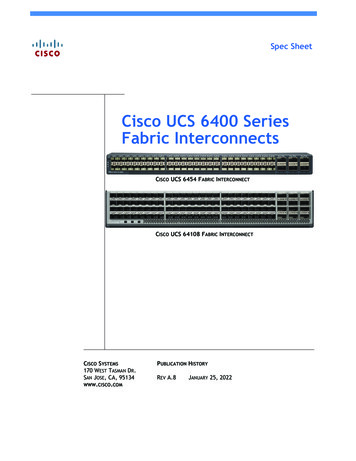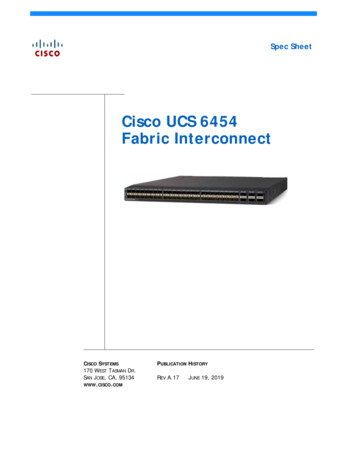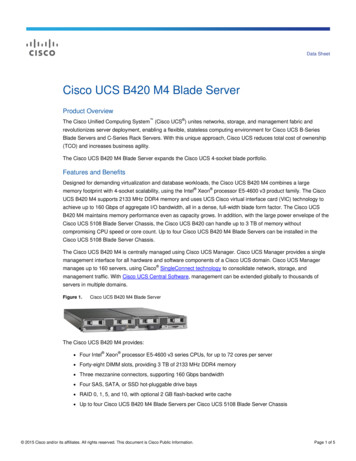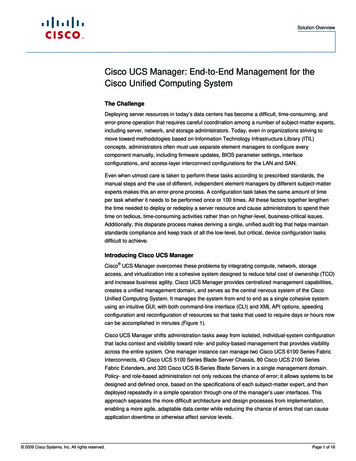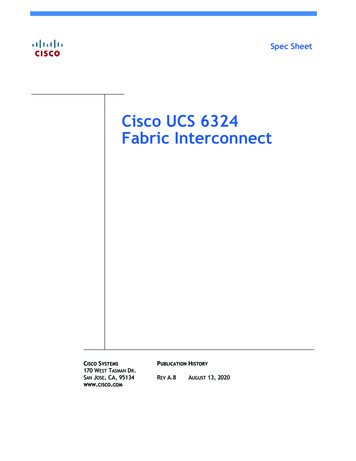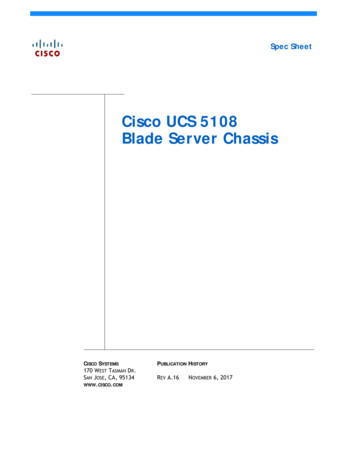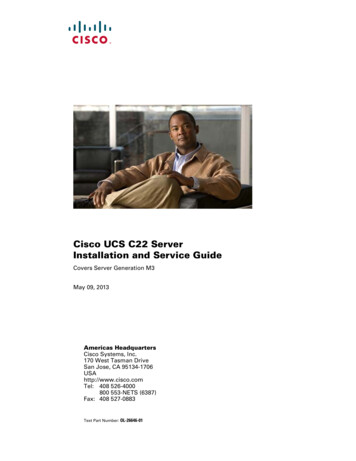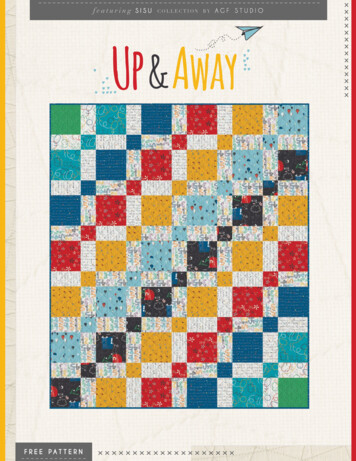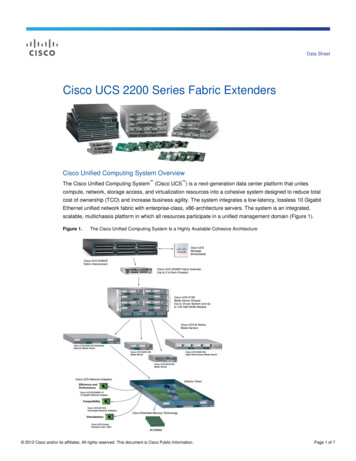
Transcription
Data SheetCisco UCS 2200 Series Fabric ExtendersCisco Unified Computing System OverviewThe Cisco Unified Computing System (Cisco UCS ) is a next-generation data center platform that unitescompute, network, storage access, and virtualization resources into a cohesive system designed to reduce totalcost of ownership (TCO) and increase business agility. The system integrates a low-latency, lossless 10 GigabitEthernet unified network fabric with enterprise-class, x86-architecture servers. The system is an integrated,scalable, multichassis platform in which all resources participate in a unified management domain (Figure 1).Figure 1.The Cisco Unified Computing System Is a Highly Available Cohesive Architecture 2012 Cisco and/or its affiliates. All rights reserved. This document is Cisco Public Information.Page 1 of 7
Product OverviewCisco UCS 2200 Series Fabric Extenders bring the unified fabric into the blade server enclosure, providing multiple10 Gigabit Ethernet connections between blade servers and the fabric interconnect, simplifying diagnostics,cabling, and management. It is a second-generation I/O module (IOM) that shares the same form factor with thefirst-generation Cisco UCS 2100 Series Fabric Extenders IOM and is backward-compatible with the shipping CiscoUCS 5108 Blade Server Chassis.The Cisco UCS 2200 Series extends the I/O fabric between the Cisco UCS 6100 and 6200 Series FabricInterconnects and the Cisco UCS 5100 Series Blade Server Chassis, enabling a lossless and deterministic FibreChannel over Ethernet (FCoE) fabric to connect all blades and chassis together. Since the fabric extender is similarto a distributed line card, it does not perform any switching and is managed as an extension of the fabricinterconnects. This approach removes switching from the chassis, reducing overall infrastructure complexity andenabling Cisco UCS to scale to many chassis without multiplying the number of switches needed, reducing TCOand allowing all chassis to be managed as a single, highly available management domain.The Cisco UCS 2200 Series also manages the chassis environment (the power supply and fans as well as theblades) in conjunction with the fabric interconnect. Therefore, separate chassis management modules are notrequired.Cisco UCS 2200 Series Fabric Extenders fit into the back of the Cisco UCS 5100 Series chassis. Each Cisco UCS5100 Series chassis can support up to two fabric extenders, allowing increased capacity and redundancy(Figure 2).Figure 2.Rear of Cisco UCS 5108 Blade Server Chassis with Two Cisco UCS 2208XP Fabric Extenders InsertedCisco UCS 2208XP Fabric ExtenderThe Cisco UCS 2208XP Fabric Extender (Figure 3) has eight 10 Gigabit Ethernet, FCoE-capable, Enhanced SmallForm-Factor Pluggable (SFP ) ports that connect the blade chassis to the fabric interconnect. Each Cisco UCS2208XP has thirty-two 10 Gigabit Ethernet ports connected through the midplane to each half-width slot in thechassis. Typically configured in pairs for redundancy, two fabric extenders provide up to 160 Gbps of I/O to thechassis.Figure 3.Cisco UCS 2208XP Fabric Extender 2012 Cisco and/or its affiliates. All rights reserved. This document is Cisco Public Information.Page 2 of 7
Cisco UCS 2204XP Fabric ExtenderThe Cisco UCS 2204XP Fabric Extender (Figure 4) has four 10 Gigabit Ethernet, FCoE-capable, SFP ports thatconnect the blade chassis to the fabric interconnect. Each Cisco UCS 2204XP has sixteen 10 Gigabit Ethernetports connected through the midplane to each half-width slot in the chassis. Typically configured in pairs forredundancy, two fabric extenders provide up to 80 Gbps of I/O to the chassis.Figure 4.Cisco UCS 2204XP Fabric ExtenderCisco SingleConnect TechnologyCisco SingleConnect Technology is an easy, intelligent, and efficient way to connect and manage computing in thedata center. Cisco SingleConnect unifies LAN, SAN, and systems management into one simplified link for rackservers, blade servers, and virtual machines.SingleConnect is an end-to-end I/O architecture. It incorporates Cisco Virtual Interface Cards, Cisco UCS FabricInterconnects, and Cisco Fabric Extender (FEX) Technology to connect every server on a single network fabric andon a single network layer. SingleConnect innovations dramatically simplify IT operations, reduce data center costs,and are exclusive to the Cisco Unified Computing System (Cisco UCS).Cisco SingleConnect is one connection: For rack servers and blade servers For LAN, SAN, and systems management For physical servers and virtual machinesFeatures and BenefitsTable 1 summarizes the main features and benefits of the Cisco UCS 2200 Series.Table 1.Features and BenefitsFeatureManagement by CiscoUCS ManagerAutoconfigurationUnified fabricBenefit Reduces TCO by removing management modules from the chassis, making the chassis stateless Provides a single, highly available management domain for all system chassis, reducing administrative tasksSimplifies operation by automatically synchronizing firmware levels between the fabric extenders and theinterconnects Decreases TCO by reducing the number of network interface cards (NICs), host bus adapters (HBAs), switches,and cables needed Transparently encapsulates Fibre Channel packets into EthernetAutomatic failoverIncreases availability with an active-active data planeScalable bandwidthReduces TCO by optimizing overall system capacity to match actual workload demandsEnvironmentalmonitoringRemoves the need for chassis management modulesLossless fabricProvides a reliable, robust foundation for unifying LAN and SAN traffic on a single transportPriority flow control(PFC) Simplifies management of multiple traffic flows over a single network link Supports different classes of service, allowing both lossless and classic Ethernet on the same fabric 2012 Cisco and/or its affiliates. All rights reserved. This document is Cisco Public Information.Page 3 of 7
FeatureBenefitSystemwide bandwidthmanagementHelps enable consistent and coherent quality-of-service (QoS) management throughout the systemCisco Data CenterVirtual Machine FabricExtender (VM-FEX)technology Helps enable a consistent operational model between virtual and physical environments Provides the same level of network visibility for virtualized and nonvirtualized environmentsSFP ports Increases flexibility with a range of interconnect solutions, including copper Twinax cable for short runs and fiberfor long runs Consumes less power per port than traditional solutions Improves diagnostic and troubleshooting capabilities in a virtual environment Simplifies network and security policy enforcement when migrating virtual machines from one host to another Helps enable cost-effective connections on fabric extenders with Cisco Fabric Extender Transceiver (FET) opticsFabric PortChannel Provides flexibility to bundle fabric ports in a PortChannelProduct SpecificationsCablingTable 2 presents cabling specifications for the Cisco UCS 2200 Series.Table 2.Cabling SpecificationsConnector (Media)CableDistancePower(Each Side)TransceiverLatency (Link)StandardSFP copper (CU)Twinax1, 3, and 5mApproximately 0.1watt (W)Approximately 0.1microsecondSFF 8431SFP FETMM OM225 and 100m1WApproximately 0microsecondsIEEE 802.3ae82 and 300m1WApproximately 0microsecondsIEEE 802.3aeUp to 300m overSMF1WApproximately 0microsecondsIEEE 802.3aeMM OM3MM OM4SFP short-reach(SR) and multimode fiber (MMF)MM OM2MM OM3MM OM4SFP long-reach (LR) MMF and SRSMFPerformance Hardware forwarding at 640 Gbps Low-latency cut-through design, providing predictable, consistent traffic latency regardless of packet size,traffic pattern, or enabled featuresLayer 2 Layer 2 VLAN trunks IEEE 802.1Q VLAN encapsulation Support for up to 1024 VLANs and virtual SANs (VSANs) Support for Cisco Data Center VM-FEX architecture Jumbo frames on all ports (up to 9216 bytes) Pause frames (IEEE 802.3x) 2012 Cisco and/or its affiliates. All rights reserved. This document is Cisco Public Information.Page 4 of 7
QoS Layer 2 IEEE 802.1p (class of service [CoS]) CoS-based egress queuing Egress strict-priority queuing Egress port-based scheduling: Weighted Round-Robin (WRR) Eight hardware queues per portHigh Availability Up to two fabric extenders can work in the Cisco UCS 5100 Series Blade Server Chassis Active-active data-plane operation with failover Capability to fail over from one fabric extender to another in the event of a failure Active-passive management-plane operation Support for nonstop management-plane functions; if the active fabric extender fails, the passive fabricextender takes over the chassis management functionsManagement Management of fabric extenders integrated into Cisco UCS Manager (please refer to the Cisco UCSManager data sheet for more information about management interfaces) Capability to manage blade server chassis components such as power supplies, fans, and blades inconjunction with the fabric interconnect Firmware levels between the fabric extender and fabric interconnect always synchronizedLow-Latency, Lossless 10 Gigabit Ethernet Unified Network Fabric PFC (per-priority pause frame support) Data Center Bridging Exchange (DCBX) Protocol IEEE 802.1Qaz: Bandwidth managementIndustry Standards IEEE 802.1p: CoS prioritization IEEE 802.1Q: VLAN tagging IEEE 802.3: Ethernet IEEE 802.3ad: Link Aggregation Control Protocol (LACP) IEEE 802.3ae: 10 Gigabit Ethernet SFP support 2012 Cisco and/or its affiliates. All rights reserved. This document is Cisco Public Information.Page 5 of 7
Physical SpecificationsSFP OpticsCisco UCS products support 10 Gigabit Ethernet SFP copper Twinax cables for short distances and SFP opticsfor longer distances. SFP has several advantages compared to other 10 Gigabit Ethernet connectivity options,including: Small 10 Gigabit Ethernet form factor Optical interoperability with XENPAK, X2, and 10 Gigabit Small Form-Factor Pluggable (XFP) interfacetypes Low power consumption Hot-swappable deviceEnvironment Physical (height x width x depth): 7.64 x 1.36 x 7.2 in Operating temperature: 32 to 104 F (0 to 40 C) Nonoperating temperature: -40 to 158 F (-40 to 70 C) Humidity: 5 to 95% (noncondensing) Altitude: 0 to 10,000 ft (0 to 3000m)Weight 2.5 lb (1.134 kg); Weight similar for Cisco UCS 2208XP and 2204XP IOMsRegulatory Standards Compliance: Safety and EMCTable 3 summarizes Cisco UCS 2200 Series regulatory compliance.Table 3.Regulatory Standards Compliance: Safety and EMCSpecificationDescriptionRegulatory complianceProducts should comply with CE Markings according to directives 2004/108/EC and 2006/95/ECSafety UL 60950-1 CAN/CSA-C22.2 No. 60950-1 EN 60950-1 IEC 60950-1 AS/NZS 60950-1 GB4943EMC: Emissions 47CFR Part 15 (CFR 47) Class A AS/NZS CISPR22 Class A CISPR22 Class A EN55022 Class A ICES003 Class A VCCI Class A EN61000-3-2 EN61000-3-3 KN22 Class A CNS13438 Class A 2012 Cisco and/or its affiliates. All rights reserved. This document is Cisco Public Information.Page 6 of 7
SpecificationDescription EN50082-1 EN61000-6-1EMC: Immunity EN55024 CISPR24 EN300386 KN 61000-4 seriesRoHSThe product is RoHS 5-compliant with exceptions for leaded ball grid array (BGA) balls and lead press-fitconnectorsWarranty InformationFind warranty information at Cisco.com on the Product Warranties page.Cisco Unified Computing ServicesUsing a unified view of data center resources, Cisco and our industry-leading partners deliver services thataccelerate your transition to a unified computing environment. Cisco Unified Computing Services helps you quicklydeploy your data center resources and optimize ongoing operations to better meet your business needs. For moreinformation about these and other Cisco Data Center Services, visit http://www.cisco.com/go/dcservices.For More InformationFor more information about the Cisco UCS 2200 Series Fabric Extenders, ndex.html or contact your local Cisco representative.Printed in USA 2012 Cisco and/or its affiliates. All rights reserved. This document is Cisco Public Information.C78-675243-0311/13Page 7 of 7
UCS 5108 Blade Server Chassis. The Cisco UCS 2200 Series extends the I/O fabric between the Cisco UCS 6100 and 6200 Series Fabric Interconnects and the Cisco UCS 5100 Series Blade Server Chassis, enabling a lossless and deterministic Fibre Channel over Ethernet (FCoE) fabric to connect all blades and chassis together. Since the fabric extender .
